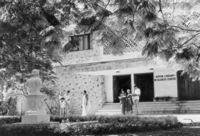Difference between revisions of "Adyar Library and Research Center"
| Line 10: | Line 10: | ||
The Adyar Library was originally located in the Headquarters building of the Theosophical Society, on the banks of the Adyar river. There were two rooms to the east of the Great Hall for books and manuscripts and a long room on the river front was used as a Reading room. | The Adyar Library was originally located in the Headquarters building of the Theosophical Society, on the banks of the Adyar river. There were two rooms to the east of the Great Hall for books and manuscripts and a long room on the river front was used as a Reading room. | ||
| − | [[image: | + | [[image:TE_library_adyar2.jpg|thumb|200px|''Adyar Main Headquarters Building'']] |
As early as 1888 Friedrich Max Müller, German-British Orientalist and Philologist (1823-1900), wrote to Olcott suggesting that the Theosophical Society should specialize in the Upaniadic literature (''see'' UPANIṢADS). In the early years an edition of Minor ''Upaniṣads'' and a descriptive catalogue of the Upaniṣadic literature were published. Later authentic texts of all the 108 Upaniṣads with the ADVAITIC commentary of ''Upaniṣad Brahmayogin'' were published and English translations on the basis of the commentary have also been issued for most of them. | As early as 1888 Friedrich Max Müller, German-British Orientalist and Philologist (1823-1900), wrote to Olcott suggesting that the Theosophical Society should specialize in the Upaniadic literature (''see'' UPANIṢADS). In the early years an edition of Minor ''Upaniṣads'' and a descriptive catalogue of the Upaniṣadic literature were published. Later authentic texts of all the 108 Upaniṣads with the ADVAITIC commentary of ''Upaniṣad Brahmayogin'' were published and English translations on the basis of the commentary have also been issued for most of them. | ||
Revision as of 05:06, 23 August 2011
The Adyar Library was founded on December 28, 1886 by Henry Steel OLCOTT, the Founder President of the Theosophical Society (TS), as an integral and basic part of the Theosophical Society. The main aims of the library as laid down by Olcott were:
(1) to establish a nucleus for the comparative study of Eastern and Western philosophies and religions.
(2) to revive Oriental Literature.
(3) to rehabilitate the true Pandit in public esteem.
(4) to promote a higher moral sense and spiritual aspiration among Asiatic youth and
(5) to inculcate mutual regard between the learned of the East and the West.
This aim of the founder, to make a judicious combination of excellence in Eastern traditional scholarship and the best traits of modern research methodology and textual criticism, still remains valid.
The Adyar Library was originally located in the Headquarters building of the Theosophical Society, on the banks of the Adyar river. There were two rooms to the east of the Great Hall for books and manuscripts and a long room on the river front was used as a Reading room.
As early as 1888 Friedrich Max Müller, German-British Orientalist and Philologist (1823-1900), wrote to Olcott suggesting that the Theosophical Society should specialize in the Upaniadic literature (see UPANIṢADS). In the early years an edition of Minor Upaniṣads and a descriptive catalogue of the Upaniṣadic literature were published. Later authentic texts of all the 108 Upaniṣads with the ADVAITIC commentary of Upaniṣad Brahmayogin were published and English translations on the basis of the commentary have also been issued for most of them.
A research journal called Adyar Library Bulletin — Brahma-Vidyā, was started in 1937 and 56 volumes have been published. One Hundred and forty volumes of books including descriptive catalogues of the library manuscripts, critical editions and translations of important texts in philosophy, literature and music in Sanskrit and Prakṛit and Tamil have been published.
The Library moved into its new building in February 1967. The plinth area of the ground floor is 980 sq. meters and of the second floor is 385 sq. meters. The building is provided with spacious and airy work rooms and with separate stacks for the oriental and western sectors, the manuscripts and periodicals. Two rooms for the manuscripts have been air-conditioned.
In recent years the library has been thoroughly modernized, improving its various services and preservation methods: air-conditioning, reprographic facilities, microfilming, microfiche reading, fumigation, lamination, binding and mechanical cleaning. A special system of classification based on the decimal system is being used and a comprehensive alphabetical card index system has been evolved to help scholars.
A major part of the library’s research collections of rare and important manuscripts covering different areas of knowledge and learning remain still unexplored or not fully utilized and awaits competent and devoted scholars as well as further financial resources to fulfil its role in indological research.
At its inception the library had books in 24 languages with many rare manuscripts acquired by Olcott and others. By 1937 the stock had grown in the Eastern Section to 7,000 oriental manuscripts and 14,000 printed books, while the Western Section had grown to 39,000 books. At present the library has a collection of more than 2,000,000 printed books and 18,700 manuscripts.
Publications of the Adyar Library up to 1994 include: 32 Vidyās; 108 Upaniads with Commentary; Vedānta Paribhaa with English translation; Jīvanmuktiviveka with English translation; Laghu yogavāsita in English translation; Philosophy of Viśiṣṭādvaita; Haṭhayoga Pradīpikā; Stotra; Viṣṇusahāsranāma and Bhāṣya of Śamkara with English translation; Lalitāsahasranāma and commentary with English translation.
Literature: Naiṣadhānanda of Kṣemīśvara (A Drama); Udayarāghāvā Mahakavya (ed.); Sriharicaritamahakavya (ed.)
Poetry: Alaṇkārasangraha (ed); The Numbers of Rasas; The Science of Criticism in India.
Logic: Maṇikaṇa (ed.) with translation; Gamgeśa’s Philosophy of God; Caturdaśalakṣani (ed.); Rasarnavasudhakara (ed.); Rasakalika Text and translation.
Āgamas: Ahirbudhñya Samhitā; Lakṣmītantra; Descriptive Catalogues of Manuscripts. 10 volumes.
Dharmaśāstra: Viṣṇu Smṛti with commentary.
Lexicography: Amarakośa with South Indian commentaries.
Philosophy: Indian Theories of Meaning; Mānameyodaya with translation.
© Copyright by the Theosophical Publishing House, Manila
